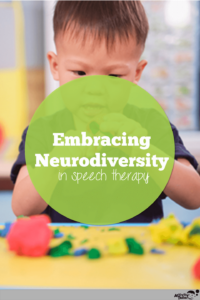Embracing neurodiversity in speech therapy and life choices is vital for providing the best support possible for neurodivergent children.
The term “neurodivergent” is an umbrella term that encompasses Autism, ADHD, dyslexia, and other diagnoses. Neurodiversity essentially is the concept that some individuals’ developmental pathways develop differently than the majority of the population (referred to as neurotypical persons).
This term acknowledges the diversity of the human race and each individual person.
With neurodivergence in mind, one should consider neurodiversity-affirming language and approaches to selecting therapy and strategies in therapy.
First thing’s first: neurodiversity-affirming explained
The main idea behind being neurodiversity-affirming is NOT viewing a difference as a bad thing. With this in mind, the goal for therapy is no longer to have the child acquire language and interact “like everyone else”.
The goal shifts from becoming more like a neurotypical child to helping a neurodiverse child access their communication and language skills in a way that makes sense with their specific developmental path. The same is true for other developmental skills within the classroom too!
Neurodiversity-affirming language
To be neurodiversity-affirming, you will also need to check the language you use to communicate with. Neurodivergent adults have spoken out to express that they prefer identity-first language vs person-first language
Example: Autistic child vs child with autism
By shifting to use this sort of language, you are validating that a diagnosis is not a set of symptoms that a child deals with but rather who the child is as a person. Identity-first language celebrates a child for exactly who he or she is!
Your words speak life and belief into your child’s abilities to perform (or not!)…it matters how you say it!
Strengths-based approach
A neurodivergent child is seen as a whole person– for their strengths, differences, interests, and areas of weakness. They are no longer only viewed through the lens of impairments, delays, and deficits.
With this strengths-based approach in mind, parents and SLPs aim to provide their children and clients with adaptations and supports that support their neurodiversity. The parents’ goal of pursuing therapy and the therapist’s goal in therapy is not because they believe a child must be fixed or will be taught to become like “typically developing children”.
Examples
Eye Contact
Instead of viewing lack of eye contact as a pragmatic language weakness that needs to be corrected, instead consider other ways a child may be demonstrating their attention to you when spoken to. Does her body turn slightly towards you? Does he rock his body slower or faster when you speak? What is this relaying to you about their individual development?
Play
For the kids who have previously been observed as “unproductive” or “non-play” children, take time during your sessions or at home to figure out how your child’s preferred actions demonstrate their unique developmental pathways. Oftentimes, these modes of play are related to special interests which also help reveal more about him or her.
Instead of taking a significant amount of time trying to address “how to play appropriately” (aka like a neurotypical child), consider ways to target appropriate language goals within the unique actions your child enjoys.
Hearing from Autistic Adults
Spearheaded by the Autistic adult community, there is a great movement away from ABA approaches. ABA is applied behavior analysis, most often a behavior modification method for autistic individuals.
This movement is because ABA therapies and approaches stem from altering behaviors, often looking from deficits first and then determining steps to change a child’s actions into what is neurotypical. This happens with play, eye contact, stimming, and more.
Unfortunately, this results in little to no time spent looking at a child’s individuality, strengths, and special interests in regards to his or her unique development.
Many Autistic adults report post-traumatic stress disorders or other mental health issues as a direct result of past ABA therapy or ABA-based approaches.
What does this mean for me?
As an SLP, this means that you most likely need to adapt your way of thinking from a deficit-focused lens that’s alerted by “red flags” or “delays” to that of one that is neurodiversity-affirming.
Staying up to date on research is already a part of who you are, but this requires extra focus to ensure your clients can grow into their fullest potential and families are supported in the best way possible.
For parents, this means you continue to take the reins as your child’s best advocate.
You will select therapists and teachers who understand neurodiversity and use strengths-based approaches with your child’s individuality and mental health in mind.
You will also encounter medical professionals, teachers, family members, strangers, and even therapists who are unaware of this neurodiversity movement. You will have many opportunities to educate others around you on the importance of viewing individuals (your child especially!!) through their strengths instead of weaknesses.
Learn more about Neurodiversity!
Read Uniquely Human by Dr. Barry Prizant
Watch Famly’s free webinar “Developing Neurodiversity-Affirming Practice in the Early Years”
You may also be interested in reading:
The Importance of Early Intervention
What to Expect from a Speech and Language Evaluation







